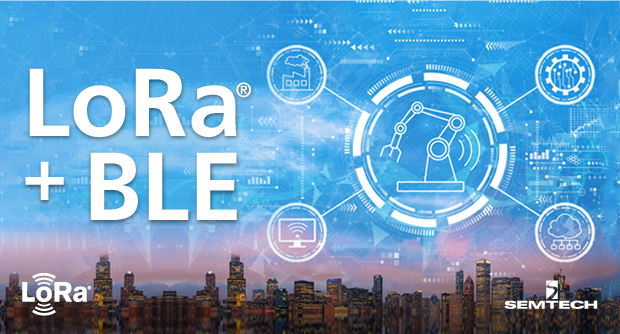When it comes to connecting Internet of Things (IoT) devices, there is no one-size-fits-all protocol to address all use cases. Each connectivity option has trade-offs between power consumption, bandwidth and range.
Fortunately, users can now combine both long range and short range connectivity as a hybrid module. Integrating LoRa® and Bluetooth Low-Energy (BLE) creates synergies that maximize efficiency while producing a low-cost infrastructure.
Bluetooth technology is capable of sending data continuously over a short distance, usually less than 10 meters. Bluetooth was originally intended for point-to-point or point-to-multipoint data exchange among consumer devices. Optimized for power consumption, Bluetooth BLE was introduced to small-scale consumer IoT applications, including fitness and medical wearables, and smart home devices, replacing cables and wires when streaming audio files or small video files. It found its niche as a protocol of choice for communication between any smartphone, tablet or laptop with a smart device in direct proximity e.g., for configuration or updating its firmware. BLE is ideal for short-range communication with a high throughput.
On the other hand, Semtech’s LoRa device-to-Cloud platform and the LoRaWAN® standard have been architected for long range low power wireless connectivity to optimally serve applications such as smart metering, smart cities, asset tracking over large geographic areas, and industrial monitoring.
When BLE and LoRa are combined, the whole technology is greater than the sum of its parts and provides benefits to customers in the following use-cases:
Transfer Large Files
A grid infrastructure is where LoRa brings the lowest total cost of ownership (TCO) when sending periodic meter readings. With a hybrid IoT, it is much easier to occasionally transfer large files of data over the sensor. For instance, this may be necessary when a sensor must be reconfigured through firmware updates over-the-air (FUOTA).
Easy Access
For general installers or technicians, the process of controlling sensor devices does not require special skills or extensive knowledge how to connect with a LoRaWAN network. Rather, commissioning and diagnosing the device is as straightforward as a consumer-like solution and can be accomplished from a phone or laptop.
Backup Connectivity
If there is an issue with the sensor being unable to send data or an area with low coverage from a low power wide area network (LPWAN), backup BLE connectivity can be used to access the accumulated data. This guaranteed backup access and control provides fail-safe connectivity and prevents loss of valuable information.
If there is an issue with the sensor being unable to send data or an area with low coverage from a low power wide area network (LPWAN), backup BLE connectivity can be used to access the accumulated data. This guaranteed backup access and control provides fail-safe connectivity and prevents loss of valuable information.
Expand asset tracking
For tracking valuable goods traveling on a container or pallet, LoRa is widely used to enable the tracking of moving assets with GNSS location scanning over a large geographic area. Yet, leveraging an infrastructure that already has BLE beaconing deployed can extend indoor location coverage.
Upgraded BLE Network
Enhancing a preexisting BLE short-range sensing network with a straight-to-Cloud low power long range LoRaWAN connectivity has many advantages. For instance, industrial IoT applications may already have some installed wireless sensors that use BLE. Now, with the installation of a LoRa plus BLE module, there is a BLE network bridging LoRaWAN to uplink consolidated information into the Cloud – replacing the existing operator’s time-consuming and costly manual reading process
We are beginning to see customers adopt widely this hybrid combination of a BLE chip with products throughout Semtech’s entire LoRa portfolio in the various sub-GHz ISM bands across Europe, U.S., and APAC – each with different sub-GHz frequency requirements.
On the other hand, we also see the ecosystem and demand for a worldwide interoperable single frequency growing. Application developers and network providers desire a solution that provides long range low power connectivity within a uniform frequency globally.
Introducing LoRa 2.4GHz to Maximize Synergies With BLE
With the LoRa 2.4GHz chip SX1280, customers can leverage the connectivity capabilities of LoRa technology in the 2.4GHz ISM band with a full edge-to-Cloud solution. When combined with BLE, the integration works even better and at a lower cost. Essentially, the two technologies transmit data on the exact same band frequency for a more compact integration.
Sharing the same radio frequency (RF) band allows manufacturers to design for a single RF path. This functionality makes the design process simpler and at a lower cost because you only have one antenna, resulting in lower bill of materials (BOM).
Hybrid solutions bring what once were considered competing technologies into a holistic offering that combines the strengths of combined connectivity protocols.
Written by Carlo Tinella. Senior Product Manager, Wireless and Sensing Products Group

